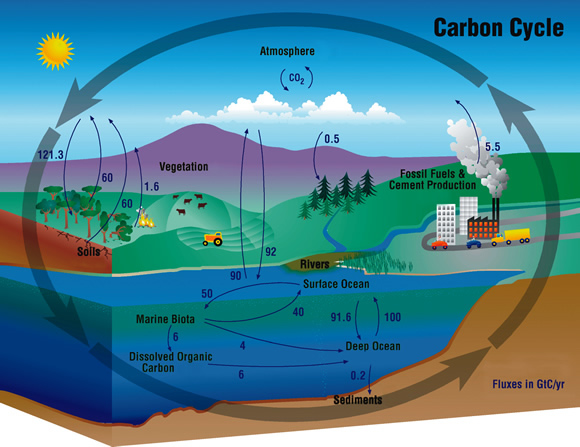
Some groups collect water samples from the oceans, analyzing them for carbon content.

Scientists from around the world are working to understand the forces behind the movement of carbon. The processes involved in the carbon cycle are large and complex. What are ocean scientists doing to understand the carbon cycle? When carbon sinks to the deep ocean, with some reaching the ocean floor, it can be locked away for millennia, so oceans can play a critical role in ultimately helping to fight climate change. Such ocean acidification is harmful to ocean life, especially corals and other organisms whose shells are damaged by the acidic waters. Additionally, when carbon dioxide reacts with surface water, it creates carbonic acid, which is causing ocean waters to become more acidic. But oceans cannot continue to sop it up indefinitely, and there are signs that the rate of absorption might be slowing. Oceans have absorbed much of the carbon dioxide people have released into the atmosphere, slowing the rate of warming. As we increase levels of this gas in the atmosphere, we have been causing Earth to warm, which has wide-ranging implications. A greenhouse gas, carbon dioxide acts as a blanket, trapping heat from the sun and holding it close Earth’s surface. Human activity has driven up atmospheric carbon dioxide to levels not seen in more than 800,000 years. Centuries later-and far from its original location-the water warms and rises again to the surface, releasing carbon dioxide back into the atmosphere. This cold, dense water then sinks to the seafloor where it flows slowly through ocean basins in deep ocean currents. Such processes may eventually create coal or oil deposits deep underground.Ĭold water absorbs more carbon dioxide than warm water, so ocean water near the poles tends to soak up more of the gas. When marine animals die, their bodies may sink into the depths, where the carbon they contain either gets dissolved back in to deep waters, or a smaller fraction settles to the seafloor where it is covered in sediment and locked away for centuries. Plant-like phytoplankton living in the ocean convert carbon dioxide into sugars that feed marine ecosystems. Surface waters exchange gases with the atmosphere, absorbing and releasing carbon dioxide, oxygen, and other gases. The oceans play a particularly important role in the carbon cycle.

This movement of carbon from one place to another, which is caused by natural and human processes, is known as the carbon cycle.

Individual atoms move from one reservoir to another: between the atmosphere and the oceans, from plants to animals to decomposers, to sediments and rock, and eventually back to the atmosphere. It’s found in the cells of all living things, is abundant in rocks and sediments, and is also found in the atmosphere and ocean. Other Expeditions Highlighting WHOI ResearchĬarbon makes up the backbone of all life on Earth.Expedition to Stellwagen Bank National Marine Sanctuary.How do polynyas help feed emperor penguins?.Why is pressure different in the ocean?.What’s the difference between climate and weather?.


 0 kommentar(er)
0 kommentar(er)
